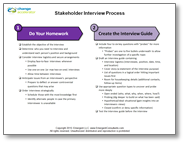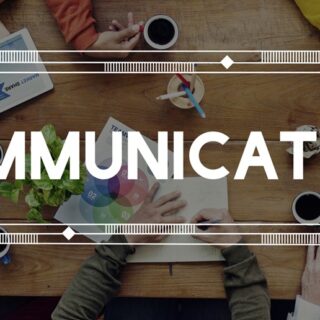
Interviewing stakeholders, along with focus groups and surveys, is one of the primary methods of gathering qualitative data. Insights gleaned from stakeholder interviews provide the basis for stakeholder analysis and prioritization and serve as a critical step in formulating an effective organizational change strategy. Stakeholder interviews done well yield many benefits:
- Correct structures, processes, and people targeted for improvement
- People who more likely to participate in future interviews
- Increased credibility through time well spent together
- Accurate conclusions and informed decisions
- Positive return on investment (ROI)
There are just as many pitfalls when interviews are not done well – wrong conclusions, wasted time, wasted money, lost credibility, and people less likely to participate next time. Therefore how you conduct stakeholder interviews is very important. The five steps below will prepare and guide you through an effective interview process:
Step 1: Do your homework
- Establish the objective of the interview
- Determine who you need to interview and understand each person’s position and background
- Consider interview logistics and secure arrangements
- Anticipate issues from an interviewee’s perspective
- Order interviews strategically
Step 2: Create the interview guide
- Include four to six key questions with “probes” for more information
- Draft an interview guide
- Use appropriate question types to uncover and probe more deeply
- Test the interview guide before the interview
Step 3: Open the interview
- Introduce yourself
- Establish a rapport—remember you’re likely viewed as an outsider prying into the interviewee’s area
- Explain the cover story
- Clarify objectives and set the agenda
- Solicit feedback on the agenda and discussion objectives
- Be responsive to interviewee’s interest in discussing additional relevant topics or perspectives
Step 4: Use conversational questioning
- Incorporate normal elements of social dialog
- Verbalize your understanding (“If I understood you…”)
- Use neutral phrases to encourage the interviewee (“I see”)
- Use pauses to encourage the interviewee to go on—most will continue to go deeper into a topic if you let them
- Clarify vague comments (“How did you mean that?”)
- Highlight and clarify inconsistencies
- Control the interview only as necessary to ensure you cover all the key questions but allow the interview to influence the order and other interview dynamics
- Listen actively for meaning and emotion as well as for the facts
Step 5: Close the Interview
- Summarize key points to check your understanding
- Review any documentation you have discussed to ensure comprehension
- Allow interviewee time to voice concerns related to the purpose of the meeting or situation
- Create an open door for contacting the interviewee again for more information or clarification
- Thank the interviewer for their time
- DO NOT promise results of your other interviews unless you actually plan to aggregate and deliver them
 Following these guidelines will ensure that you use your time efficiently and that you gather relevant data and quality information. Download the Stakeholder Interview Process Tool. If you would like help analyzing stakeholders as part of your strategic business initiative, contact us. Also, you can find other valuable stakeholder tools like this one as part of the Change Accelerator toolkit.
Following these guidelines will ensure that you use your time efficiently and that you gather relevant data and quality information. Download the Stakeholder Interview Process Tool. If you would like help analyzing stakeholders as part of your strategic business initiative, contact us. Also, you can find other valuable stakeholder tools like this one as part of the Change Accelerator toolkit.












2 comments
Pingback: How to Conduct High-Impact Focus Groups «
Jeremy Kennedy, PMP
at 2:41 pm
Excellent resource and more practical than others I’ve read or tried. It’s very clear and targets the main goal of one-on-one interviewing – that is differentiating a business requirement vs. a stakeholder desire.
Thank you very much as this is a great asset to my instruction materials and application as a project manager.
Jeremy Kennedy, PMP
Atlanta, GA USA